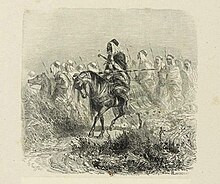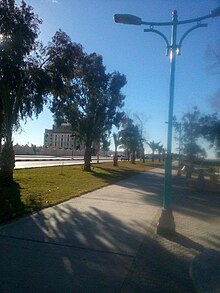Biskra
Due to its geographical location, its climate and natural resources, particularly farming, Biskra has always been a crossroad between the cities in the north and south.
say its name comes from "Vescera", which means "station" or "place" of commercial exchange, due to its location connecting north and south.
However, references in ancient Egypt of certain tribes go back to 1350 BC, during the reign of Akhenaten of the eighteenth dynasty, speak of cattle trade with this people.
Following this victory, Sheshnaq married the pharaoh's daughter, settled on the throne of Egypt under the name of Sheshonq in 952 BC, and founded the 22nd Dynasty.
While traversing the desert, the Gaetuli arrived with the Taureg at Tassili, where they stayed for an extended time and subsequently mixed with the Tuareg and learned the Tamazight language for cultural and commercial exchanges.
In Algeria, they settled at the edge of the Aures, where they posed problems to Roman infiltration in the 3rd century BC as they were stellar horsemen and became dreaded in combat.
With the help of the inhabitants of the city, who provided human and material support, Jugurtha destroyed the Roman army at the end of the so-called Numidia region.
They remained with such vigilance until the arrival of the Arab conqueror Uqba ibn Nafi al-Fihri in the 7th century AD.
His death was organized by an ambush mounted by his adversary, the Numidian prince (Berber) Koceila and his army at Tahouda, a small village located 5 km from the oasis "Sidi Okba".
Biskra became an important hub for the Hafsid of Tunisia where it remained under lure monarchy and direction for a long time then under the authority of the Marinid Sultanate of Fez and banned Abd-Elouadi and the Znatiyin of Tlemcen.
At the end of the 19th century Biskra, a popular spa town and gateway to the Sahara, became a center for artists and photographers such as Émile Frechon [fr], Alexandre Bougault and Rudolf Franz Lehnert.
From 1872 to 1920 the French Count Albert Landon de Longueville hosted in his villa-cum-chateau at Biskra (today Villa Bénévent), nobility, artists and writers, including Béla Bartok, Oscar Wilde, Scott and Zelda Fitzgerald, André Gide, Nasreddine Dinet, Eugène Fromentin, Karl Marx, Anatole France, Francis James and Henri Matisse.
Biskra is the setting of key sections of André Gide's 1902 novel The Immoralist and lesser known 1897 prose-poem Les nourritures terrestres (The Fruits of the Earth), and he visited the town in 1895 (for a fortnight from 31 January) with Lord Alfred Douglas, following a meeting with Oscar Wilde in Blida and Algiers.
The French artist Henri Matisse has a work titled Blue Nude (Souvenir de Biskra) an oil painting finished in 1907.
[citation needed] The Polish composer Karol Szymanowski, who traveled to North Africa, seemed to have been quite impressed by Biskra.
Winston Churchill's cousin, sculptor and author Clare Sheridan held a salon in Biskra in the 1920s and 1930s.
Small water points can be found in the outskirts of Biskra, especially in the oases and canyons of the mountains around El Kantara.
Secondly, the city was marked by the colonial phase characterized by the building of fort Saint Germain on the northern part, and the construction of a city (the colonial checkerboard) by an urban model, different from the previous one, and having undergone several extension, particularly the 1st and 2nd and the Dervau Plan, followed during the 50s, by popular extensions to the South at the expense of the palm grove and without dimensional and formal logic.
In the end the post colonial phase characterized by the proliferation of self-built no plan to urban and architectural quality at least and without model, where typological reference, which has only to be curbed, after the instruction of the laws intervention and control of the state, over the urban space, by launching large Housing development operations in the framework of ZUNH, in the form of housing communal collective or subdivision which, despite this, has not been able to resolve the demand for housing, bringing the state to promulgation, other laws havingobjective, improving urban quality, openness and diversification stakeholders.
In summer, the peaks of heat are among the highest in the country with temperatures that can exceed 49 °C (120 °F) and are similar to cities like Luxor or Phoenix.
Precipitation is quite rare despite some showers usually during the coldest months, mainly January and February, where it rains several times in the season, which brings the majority of humidity to Biskra in a year.
The extreme heat that prevails during the summer can cause violent storms at the end of it and usually occur in September, when the air humidity becomes significantly higher with an average of 41% moisture per year.
The hot, dry and sunny climate of the city sometimes attracts some inhabitants of the northern regions as in the city of Batna located 115 km northeast, which experiences fairly icy and wet winters during this period, to enjoy the pleasant weather and sunny in winter.
Biskra very rarely experiences freezing days and only occurs occasionally during periods of mild cold weather.
The fauna of Biskra is characterized by a great diversity of insects such as Sacred Scarab and yellow broad-tailed scorpions are found.
A variety of birds including Black Warbler, mammals such as Gazelles, small Gerboise, Fox, Wild boar, Hare, Hedgehog, Bat, Myriapods, Crustaceans such as the Crab stream or the Water Flea.










